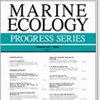浅水热液喷口蟹 Xenograpsus testudinatus 的活动受潮汐、水温和光照强度的影响
IF 2.1
3区 环境科学与生态学
Q2 ECOLOGY
引用次数: 0
摘要
摘要:利用红外照明的水下延时摄影机,在连续 7 个 2-3 天的时间段内,观察了台湾龟山岛热液喷口及周边地区浅水热液喷口蟹 Xenograpsus testudinatus 的活动模式。记录了每小时的潮位、现场水温、pH 值和光照强度,以研究这些环境因素对螃蟹活动的影响。利用频谱密度图进行的时间序列分析表明,螃蟹的活动没有节律。然而,交叉相关分析和皮尔逊相关分析表明,通气孔区域的螃蟹密度与潮汐呈负相关,但与水温和光照强度呈正相关。逐步多元回归分析表明,水温、潮位和光照强度对螃蟹密度有显著的预测作用。螃蟹密度在特定潮汐期之间没有明显差异,因此之前关于泄殖腔螃蟹在枯水期大量出现的假设被否定。泄流区是捕食者的避难所,白天退潮时和水温较高时,螃蟹更为活跃。外围区域的螃蟹密度与潮汐呈正相关,但与 pH 值呈负相关,这表明螃蟹在涨潮时和 pH 值较低时(可能是捕食者较少的时候)觅食更为活跃。逐步多元回归显示,pH 值和潮汐是预测外围区域螃蟹密度的重要因素。本文章由计算机程序翻译,如有差异,请以英文原文为准。
Activity of the shallow-water hydrothermal vent crab Xenograpsus testudinatus is affected by tides, water temperature, and light intensity
ABSTRACT: The activity pattern of the shallow-water hydrothermal vent crab Xenograpsus testudinatus in the vent and peripheral regions of Kueishan Island, Taiwan, was observed using an underwater time-lapse camera with infrared lighting during 7 consecutive 2-3 d periods. Hourly tide levels, in situ water temperature, pH, and light intensity were recorded to examine any effects of these environmental factors on crab activity. Time series analysis using spectral density plots indicated that crab activities were not rhythmic. Nevertheless, cross-correlation analysis and Pearson’s correlation showed that crab density in the vent region was negatively correlated with tide but positively correlated with water temperature and light intensity. Stepwise multiple regression analysis showed that water temperature, tide levels, and light intensity are significant predictors of crab density. There were no significant differences in crab density among specific tide periods, and thus, a previous hypothesis that vent crabs emerge in large swarms during slack waters was rejected. The vent region is a refuge from predators, with crabs more active during daytime low tides and during periods with higher water temperatures. Crab density in the peripheral region is positively correlated with tide but negatively correlated with pH, indicating that crabs there are more active at high tides while foraging and during periods with lower pH, probably when there are fewer predators. Stepwise multiple regression revealed pH and tides were significant predictors for crab density in the peripheral region.
求助全文
通过发布文献求助,成功后即可免费获取论文全文。
去求助
来源期刊

Marine Ecology Progress Series
环境科学-海洋学
CiteScore
5.30
自引率
8.00%
发文量
238
审稿时长
3 months
期刊介绍:
The leading journal in its field, MEPS covers all aspects of marine ecology, fundamental and applied. Topics covered include microbiology, botany, zoology, ecosystem research, biological oceanography, ecological aspects of fisheries and aquaculture, pollution, environmental protection, conservation, and resource management.
 求助内容:
求助内容: 应助结果提醒方式:
应助结果提醒方式:


